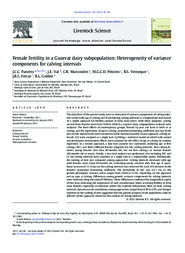Female fertility in a Guzerat dairy subpopulation: heterogeneity of variance components for calving intervals.
Female fertility in a Guzerat dairy subpopulation: heterogeneity of variance components for calving intervals.
Author(s): PANETTO, J. C. C.; VAL, J. E.; MARCONDES, C. R.; PEIXOTO, M. G. C. D.; VERNEQUE, R. da S.; FERRAZ, J. B. S.; GOLDEN, B. L.
Summary: The objectives of the present study were to determine if variance components of calving intervals varied with age at calving and if considering calving intervals as a longitudinal trait would be a useful approach for fertility analysis of Zebu dairy herds. With these purposes, calving records from females born from 1940 to 2006 in a Guzerat dairy subpopulation in Brazil were analyzed. The fixed effects of contemporary groups, formed by year and farm at birth or at calving, and the regressions of age at calving, equivalent inbreeding coefficient and day of the year on the studied traits were considered in the statistical models. In one approach, calving intervals(CI) were analyzed as a single trait, by fitting a statistical model on which both animal and permanent environment effects were adjusted for the effect of age at calving by random regression. In a second approach, a four-trait analysis was conducted, including age at first calving (AFC) and three different female categories for the calving intervals: first calving females; young females (less than 80 months old, but not first calving); or mature females (80 months old or more). Finally, a two-trait analysis was performed, also including AFC and CI, but calving intervals were regarded as a single trait in a repeatability model. Additionally, the ranking of sires was compared among approaches. Calving intervals decreased with age until females were about 80 months old, remaining nearly constant after that age. A quasilinear increase of 11.5 days on the calving intervals was observed for each 10% increase in the female's equivalent inbreeding coefficient. The heritability of AFC was 0.37. For CI, the genetic-phenotypic variance ratios ranged from 0.064 to 0.141, depending on the approach, and on ages at calving. Differences among genetic variance components for calving intervals were observed along the animal's lifetime. Those differences confirmed the longitudinal aspect of that trait, indicating the importance of such consideration when accessing fertility of Zebu dairy females, especially in situations where the available information relies on their calving intervals. Spearman rank correlations among approaches ranged from 0.90 to 0.95, and changes observed in the ranking of sires suggested that the genetic progress of the population could be affected by the approach chosen for the analysis of calving intervals.
Publication year: 2012
Types of publication: Journal article
Observation
Some of Embrapa's publications are published as ePub files. To read them, use or download one of the following free software options to your computer or mobile device. Android: Google Play Books; IOS: iBooks; Windows and Linux: Calibre.
Access other publications
Access the Agricultural Research Database (BDPA) to consult Embrapa's full library collection and records.
Visit Embrapa Bookstore to purchase books and other publications sold by Embrapa.

